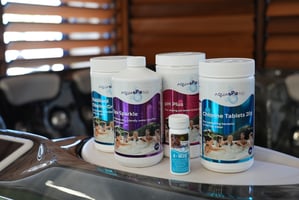Delivering hot tubs and swim spas into gardens is no small feat but fear not if there is a will...
Are Inflatable Hot Tubs Good Value For Money?
You have probably spotted those tempting deals on inflatable hot tubs, low price and easy setup. They look like a bargain. However when it comes to inflatable hot tubs, the “cheap” tag often masks a lot of extra costs. Let’s walk through what many people don’t realise, so you can decide whether an inflatable spa makes sense or whether a hard-shell model might serve you better in the long run.
What Feels Cheap Up Front Often Costs More Later
An inflatable hot tub can feel like a low-risk option: less investment, no permanent installation, flexible positioning. But what really matters is the total cost over time, not just what you pay today. Here are the hidden expenses and compromises we wish more people knew about.
1. Short Lifespan & Durability
-
Inflatable models are built with softer materials (PVC, vinyl etc.) and more seams. These are more vulnerable to wear, leaks, UV damage, and cold/frost.
-
Many owners replace inflatables after a couple of years. By contrast, a good hard-sided hot tub, with solid insulation and durable shell, can last 15-20 years with proper care.
-
That means you may save now, but pay again sooner.
2. Heat Loss & Poor Thermal Efficiency
-
Inflatable tubs lose heat fast: through thin walls, minimal insulation, and sometimes less effective covers. Wind, cold nights, or chilly ground all increase losses.
-
It takes longer to heat up, and you’ll likely need the heater on more often to keep the water at a comfortable temperature. That means more electricity and higher running costs. In colder months, or nations with modest insulation and frequent chill, this adds up significantly.
3. Water & Maintenance Intensive
-
Smaller filters, less effective circulation, more frequent chemical balancing, your water quality can degrade faster with heavy use. That forces more frequent water changes, filtration, and chemical input.
-
Replacement parts (filters, hoses, sometimes the liner) are often cheaper to buy, but more likely to fail or degrade.
4. Comfort & Practicality Compromises
-
Inflatable tubs often lack solid seating, moulded benches, or foot platforms. If you want to soak comfortably for an hour, or more, you’ll notice the difference.
-
Usable space is less than the box dimensions suggest, walls (when inflated) take up room, and the depth is often shallower.
How It Actually Compares: Inflatable vs Hard-Shell
Here’s what “real life” tends to look like when you stretch the numbers:
| Factor | Inflatable Hot Tub | Hard-Shell (Rigid) Hot Tub |
|---|---|---|
| Purchase Price | Lower initial outlay | Higher up front |
| Lifespan | ~3-7 years (depending on use/climate) | 15-20+ years with good care |
| Running Costs (Electricity, Heating) | Higher, especially in colder seasons or frequent use | More efficient, better insulation cuts heating losses |
| Comfort & Amenities | Basic seating, less internal depth, fewer built-in features | Molded seats, steps, better insulation, optional extras like lighting, jets, etc. |
| Safety & Structure | Requires careful siting, potential risks if not installed on strong base | Often includes safety features, more robust build, usually safer in varied conditions |
Who Can Save Money With Inflatable Tubs
We’re not saying inflatable hot tubs are always a bad idea. There are situations where they can make sense. If any of these sound like you, an inflatable might still be the better match:
-
You live somewhere with a mild climate, winters are short, or you don’t use the water much in cold months.
-
You want occasional use, not daily soaking.
-
You’re okay doing a bit more maintenance, balancing chemicals, cleaning more often, being more hands-on.
-
Comfort and luxury features aren’t high priorities, you are happy with a simple spa experience.
Smart Buying Tips Inflatable Hot Tub Buying Tips
If you decide an inflatable still feels right, here’s how to make sure you really get value:
-
Invest in the best cover you can, thick, insulated, lockable. Losing heat through the top is a major cost.
-
Prioritise strong filtration systems and easy-to-replace, quality filters.
-
Choose models with better insulation or wall thickening, or accessories (thermal bases, side jackets).
-
Plan carefully where it will sit, solid base, protection from wind, even shade.
-
Estimate running costs based on local electricity tariffs and hours of use. Do the math.
-
Factor in replacement/repair costs: covers, pumps, liners etc.
.png?width=2560&height=800&name=Untitled%20design%20(42).png)
